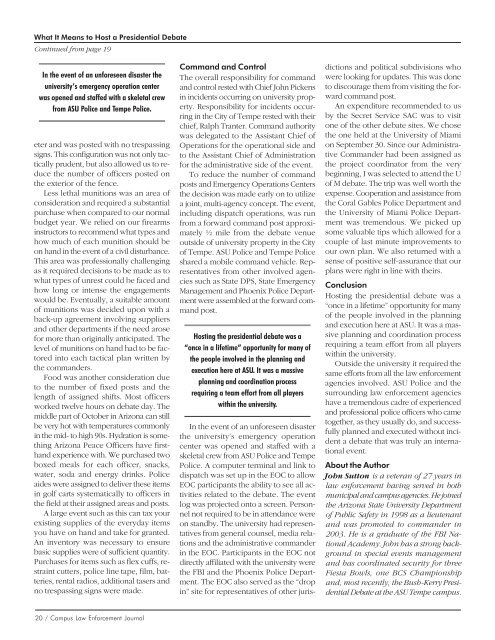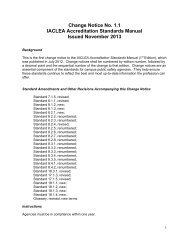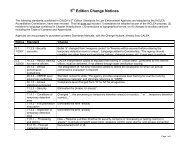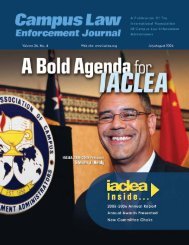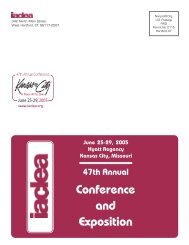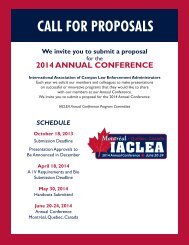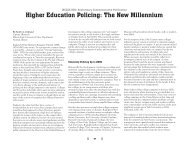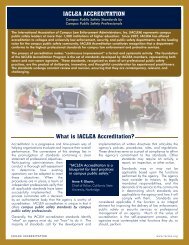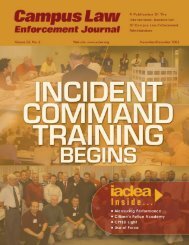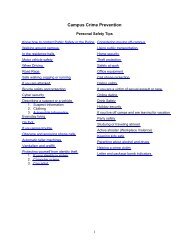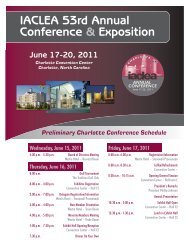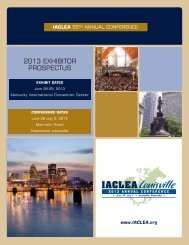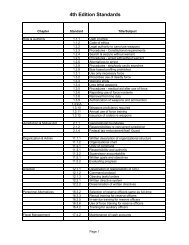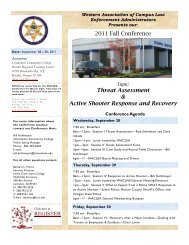Volume 36, No. 2 - March/April 2006 Campus Law ... - IACLEA
Volume 36, No. 2 - March/April 2006 Campus Law ... - IACLEA
Volume 36, No. 2 - March/April 2006 Campus Law ... - IACLEA
You also want an ePaper? Increase the reach of your titles
YUMPU automatically turns print PDFs into web optimized ePapers that Google loves.
What It Means to Host a Presidential Debate<br />
Continued from page 19<br />
In the event of an unforeseen disaster the<br />
university’s emergency operation center<br />
was opened and staffed with a skeletal crew<br />
from ASU Police and Tempe Police.<br />
eter and was posted with no trespassing<br />
signs. This configuration was not only tactically<br />
prudent, but also allowed us to reduce<br />
the number of officers posted on<br />
the exterior of the fence.<br />
Less lethal munitions was an area of<br />
consideration and required a substantial<br />
purchase when compared to our normal<br />
budget year. We relied on our firearms<br />
instructors to recommend what types and<br />
how much of each munition should be<br />
on hand in the event of a civil disturbance.<br />
This area was professionally challenging<br />
as it required decisions to be made as to<br />
what types of unrest could be faced and<br />
how long or intense the engagements<br />
would be. Eventually, a suitable amount<br />
of munitions was decided upon with a<br />
back-up agreement involving suppliers<br />
and other departments if the need arose<br />
for more than originally anticipated. The<br />
level of munitions on hand had to be factored<br />
into each tactical plan written by<br />
the commanders.<br />
Food was another consideration due<br />
to the number of fixed posts and the<br />
length of assigned shifts. Most officers<br />
worked twelve hours on debate day. The<br />
middle part of October in Arizona can still<br />
be very hot with temperatures commonly<br />
in the mid- to high 90s. Hydration is something<br />
Arizona Peace Officers have firsthand<br />
experience with. We purchased two<br />
boxed meals for each officer, snacks,<br />
water, soda and energy drinks. Police<br />
aides were assigned to deliver these items<br />
in golf carts systematically to officers in<br />
the field at their assigned areas and posts.<br />
A large event such as this can tax your<br />
existing supplies of the everyday items<br />
you have on hand and take for granted.<br />
An inventory was necessary to ensure<br />
basic supplies were of sufficient quantity.<br />
Purchases for items such as flex cuffs, restraint<br />
cutters, police line tape, film, batteries,<br />
rental radios, additional tasers and<br />
no trespassing signs were made.<br />
Command and Control<br />
The overall responsibility for command<br />
and control rested with Chief John Pickens<br />
in incidents occurring on university property.<br />
Responsibility for incidents occurring<br />
in the City of Tempe rested with their<br />
chief, Ralph Tranter. Command authority<br />
was delegated to the Assistant Chief of<br />
Operations for the operational side and<br />
to the Assistant Chief of Administration<br />
for the administrative side of the event.<br />
To reduce the number of command<br />
posts and Emergency Operations Centers<br />
the decision was made early on to utilize<br />
a joint, multi-agency concept. The event,<br />
including dispatch operations, was run<br />
from a forward command post approximately<br />
½ mile from the debate venue<br />
outside of university property in the City<br />
of Tempe. ASU Police and Tempe Police<br />
shared a mobile command vehicle. Representatives<br />
from other involved agencies<br />
such as State DPS, State Emergency<br />
Management and Phoenix Police Department<br />
were assembled at the forward command<br />
post.<br />
Hosting the presidential debate was a<br />
“once in a lifetime” opportunity for many of<br />
the people involved in the planning and<br />
execution here at ASU. It was a massive<br />
planning and coordination process<br />
requiring a team effort from all players<br />
within the university.<br />
In the event of an unforeseen disaster<br />
the university’s emergency operation<br />
center was opened and staffed with a<br />
skeletal crew from ASU Police and Tempe<br />
Police. A computer terminal and link to<br />
dispatch was set up in the EOC to allow<br />
EOC participants the ability to see all activities<br />
related to the debate. The event<br />
log was projected onto a screen. Personnel<br />
not required to be in attendance were<br />
on standby. The university had representatives<br />
from general counsel, media relations<br />
and the administrative commander<br />
in the EOC. Participants in the EOC not<br />
directly affiliated with the university were<br />
the FBI and the Phoenix Police Department.<br />
The EOC also served as the “drop<br />
in” site for representatives of other jurisdictions<br />
and political subdivisions who<br />
were looking for updates. This was done<br />
to discourage them from visiting the forward<br />
command post.<br />
An expenditure recommended to us<br />
by the Secret Service SAC was to visit<br />
one of the other debate sites. We chose<br />
the one held at the University of Miami<br />
on September 30. Since our Administrative<br />
Commander had been assigned as<br />
the project coordinator from the very<br />
beginning, I was selected to attend the U<br />
of M debate. The trip was well worth the<br />
expense. Cooperation and assistance from<br />
the Coral Gables Police Department and<br />
the University of Miami Police Department<br />
was tremendous. We picked up<br />
some valuable tips which allowed for a<br />
couple of last minute improvements to<br />
our own plan. We also returned with a<br />
sense of positive self-assurance that our<br />
plans were right in line with theirs.<br />
Conclusion<br />
Hosting the presidential debate was a<br />
“once in a lifetime” opportunity for many<br />
of the people involved in the planning<br />
and execution here at ASU. It was a massive<br />
planning and coordination process<br />
requiring a team effort from all players<br />
within the university.<br />
Outside the university it required the<br />
same efforts from all the law enforcement<br />
agencies involved. ASU Police and the<br />
surrounding law enforcement agencies<br />
have a tremendous cadre of experienced<br />
and professional police officers who came<br />
together, as they usually do, and successfully<br />
planned and executed without incident<br />
a debate that was truly an international<br />
event.<br />
About the Author<br />
John Sutton is a veteran of 27 years in<br />
law enforcement having served in both<br />
municipal and campus agencies. He joined<br />
the Arizona State University Department<br />
of Public Safety in 1998 as a lieutenant<br />
and was promoted to commander in<br />
2003. He is a graduate of the FBI National<br />
Academy. John has a strong background<br />
in special events management<br />
and has coordinated security for three<br />
Fiesta Bowls, one BCS Championship<br />
and, most recently, the Bush-Kerry Presidential<br />
Debate at the ASU Tempe campus.<br />
20 / <strong>Campus</strong> <strong>Law</strong> Enforcement Journal


